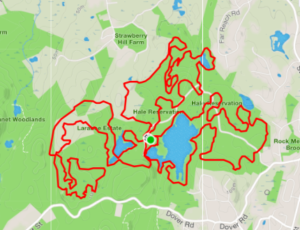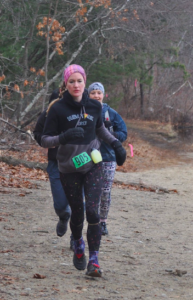TARCtic Frozen Yeti 30 Hour, February 1-2, 2020. I did a total of 45 miles, putting me in the middle of the pack of about 115 runners. Last year, I ran this race during its inaugural year and only managed 30 miles before the raw weather and general fatigue caused me to pull the plug.
As I told a race director after finishing, the 2020 TARCtic was the first race that — during the race — I went home, took a long bath, went to a basketball game, had dinner, slept in my own bed, and then returned to the race to log 15 more miles. The race organizers and volunteers were so awesome to give me an opportunity to go for more miles while not wreaking myself physically and with sleep deprivation. This course is a grind and the time of year can be a real wild card, but the organization, course markings, swag and aid station fare is world class and I will probably sign up for next year.
Race & Course Overview
The TARCTic Frozen Yeti gives runners 30 hours to complete as many miles as possible or desired on a series of three 5-mile loops (called Red, White, and Blue) that are 15 miles total. Runners get a buckle if they complete 100 miles within the 30 hours, so that’s ostensibly the goal. But it’s a miserable and difficult time of year to train in New England, and the majority of runners I talk to use the TARCtic as an off-season “tune up” race and do not aim beyond 60 miles.
All loops start and end at the Powisett Lodge at Hale Reservation, which means runners get access to the aid station, drop bags, bathrooms, and crew every 5 miles — which is an ideal frequency for hot ramen and friendly volunteers as the race wears on. In 2019, runners had to finish an entire 15-mile circuit to make it “count” towards their mileage, but this year every 5-mile loop above 30 miles counted.
Hale’s trails are considered by local runners to be deceptively difficult. The longest climbs are no more than 150 feet, and the majority are less than 50 feet — pish, easy right? And except for some technical spots on the Red Loop, it’s relatively runnable terrain. But… those little climbs, they don’t relent; the 15 mile circuit has about 2000ft of elevation gain. And… that easy terrain, it switches constantly: all in the same loop, you can get rocky leafy trails, rooty single track, a sandy beach, a mossy pond path, and crumbly pavement. Our minds might enjoy the variety, but our bodies must constantly switch gears. I have heard more than one person describe this course as a “grind” and I do think it’s because you are constantly switching gears.
Race Prep
For the TARCtic, I didn’t have any mileage goals in mind. It’s early February in Massachusetts, so obviously the weather can be a huge factor in this race. Why train for 60+ miles when one poorly-timed winter storm or cold spell could erase all motivation to do that?
My training in December and January had been mostly long hikes with elevation gain, short road runs with hill repeats, indoor cycling, and snow sports — very little straight-up trail running. But I still had some running fitness from last Fall, when I trained for the TARC Winter Fells Ultra 32-miler in early December — a notoriously technical and difficult trail race that would be a real challenge for me to finish in the time limit. I went to the Middlesex Fells almost weekly to train on the course for hours; I had a glimmer of hope that I could finish. Unfortunately, the week before the race it snowed about six inches, dashing any hope I had of finishing. So I skipped the race. (Side note: That Saturday when I should have been at the Fells Ultra, I got in a minor car accident when a 17-year old kid pulled out in front of me. The next day I wound up in the emergency room when I banged my head on a street sign while talking a walk. Neither event would have happened had I gone to the Fells Ultra. The moral of the story was… don’t skip TARC races.)
Race Morning
The weather and overall conditions for the 2020 race were pretty stellar: 30-40 degree temps, overcast, with no precipitation and little wind. More importantly, the trail was dry and devoid of snow or ice. Last year’s race had rawer weather plus a cover of snow/ice; I remember the rocky sections of the Red Loop felt particularly treacherous.
Normally I don’t like later start times for ultras, but in February, 8am feels about right. The Hale Reservation is roughly 25 minutes from my house, and I arrived and parked at Noanet Pond with more than enough to walk about a quarter mile to the lodge to get situated (there are shuttles as well).
At checkin I got my number and some swag (a race-branded dry-bag and buff, plus I had ordered sweatpants, what have turned out to be my new favorite thing). I found a place for my drop bag in the crowded main room of the lodge, ate a mini Cliff bar with some coffee, went to the restroom, and fussed with my gear. I chatted with a few people and asked how long they were planning to run (responses ranged from 30 to 75 miles); when they asked me, I said “45” but I still wasn’t really committed to anything beyond 30 miles.
Miles 0-15
The race started outside the lodge on the Red Loop, which climbs rather steeply on a pavement road before eventually turning onto a trail. This quickly sorts the runners into their proper or preferred place. I tucked in with a bunch of sensibly-paced women. The first Red Loop is essentially a conga line and a fine time to chat with others and loosen up. Still, it’s the most technical loop, and having runners at your heels does add a feeling of pressure. It’s also the longest loop (5.5 miles), so by the time we came into the lodge for the first time, I was ready for some fig newtons and a sports drink refill.
The White Loop is the most runnable loop that has a few memorable sections: power lines, dumpsters, pieces of rusting household metal fashioned into art. By then, the pack of runners had thinned out, though I started chatting with a man who’d I spend the next 7 miles leapfrogging with — I’d pass him on the climbs, and he’d pass me on the flats.
The Blue Loop goes around Noanet Pond and also has some hilly sections around the main reservation road and parking areas. there was one treacherous section on some boulders that featured slick frozen moss; like the runners around me, I had to inch down on my hands and knees. Evidently someone mentioned this section to the RDs because the next time I came around, they had routed the course to avoid the icy moss, which was a big relief.
I finished the first 15 mile circuit just before noon (~4 hours).
Miles 15-30
Red, White, Blue. I ran and stopped for ramen after every loop. By then I was largely running solo. I’m pretty sure this contributed to what happened next: As I neared the end of Blue, it was 4pm and I realized that if I stopped, I could make Little Boy’s basketball game that night. I felt good enough that I didn’t want to settle for 30 miles, yet the lure of going home was so great.
So when I finished 30 miles, I asked the nice people at the timing table if I could leave and come back the next morning. They said sure, so I gave them my bib, gathered my belongings, and walked back to my car.
Race Purgatory
So, I left the race course: I drove home, took a long soak in a hot Epsom Salt bath, drank some wine and ate pretzels, then drove to a local elementary school for Little Boy’s basketball game. His team won (largely due to having an extremely tall kid who is about my height… as a 6th grader.) For dinner, we had a satisfying raclette (melted Swiss cheese with boiled potatoes and charcuterie) and then I went to bed around 9pm after readying my downsized drop bag.
I woke up at 3:45am. My legs didn’t exactly feel fresh, but they weren’t sore, and after a quick coffee and Nutella toast, I headed back to the race for another 15 miles.
Miles 30-45
Just after 5am, I entered the Powisett Lodge, which had undergone a great change since the previous morning. Instead of being packed with scores of ripe and ready runners, there were about a dozen sleepy-looking crew members and runners. I reclaimed my bib at the timing table; the volunteers were enthusiastic that I had come back, and I bantered with them as I prepared to resume running by pinning my bib, putting on my headlamp, and opening my trekking poles. (I didn’t carry trekking poles the previous day, but given the darkness I wanted them for the technical Red loop at the very least).
Since I am an early morning runner, the darkness didn’t phase me; I listened to podcasts and progressed through the now-familiar loop, following the impeccable course flagging without issue. I did pass another runner early on the loop, but otherwise didn’t see a soul. By the time I finished Red, it was light out and the lodge was a little more lively with fresh runners arriving for the 15-mile race that started at 8am .
After eating a bunch of delicious chocolate chip cookies, I continued onto White. My legs still felt good but I knew I was moving measurably slower than the previous day. I finished White around 9am, then moved onto my last Blue lap. I wondered if I’d be able to finish Blue before the 15-milers caught up to me.
My big surprise on the Blue loop was that Mr. P and Little Boy had come to Hale to fly their new Mavic mini drone over Noanet pond. I had an inkling that they might show up! I stopped to chat with them for about ten minutes, then continued onto the lodge to finish the loop and my race. The first 15-miler passed me just as I approached the lodge. I finished and got even more great swag (a race-branded backpack and cookie); I talked with 3-4 race volunteers and left with a great feeling.
Overall, I was happy with this race. It’s a great winter tune-up race and opportunity to do some miles in a supportive atmosphere. Splitting the mileage across 2 days meant that I wasn’t completely wreaked, and could return to work on Monday without feeling particularly stressed and worn out.
As my first ultra of 2020, this marks the 8th consecutive year that I’ve done at least one ultra and brings my ultra race total to 28 (not including several DNFs where I surpassed 26.2 miles but didn’t finish).



